Anti-Croat sentiment
Anti-Croat sentiment or Croatophobia is discrimination or prejudice against Croats as an ethnic group and it also consists of negative feelings towards Croatia as a country.
| Part of a series on |
| Discrimination |
|---|
 |
Nationalism in the 19th century
With the nation-building process in the mid-19th century, the first Croatian-Serbian tensions emerged. Serbian minister Ilija Garašanin's Načertanije (1844)[1]: 3 claimed lands that were inhabited by Bulgarians, Macedonians, Albanians, Montenegrins, Bosniaks, Hungarians and Croats were part of Serbia.[1]: 3 Garašanin's plan also includes methods of spreading Serbian influence in the claimed lands.[1]: 3–4 He proposed ways to influence Croats, who Garašanin regarded as "Serbs of Catholic faith".[1]: 3 [1]: 3–4 Serbian Orthodox Church also played a vital role in promoting such ideas, with bishop Nikodim Milaš publishing influential work Pravoslavna Dalmacija (1901) claiming that the Croatian historical lands and historical-sacral heritage were Serbian since Early Middle Ages among others.[2][3]
Vuk Karadžić and other early Slavists considered everyone speaking Shtokavian dialects to be ethnic Serbs. Hence, the literary and standard Croatian language and heritage, based on Shtokavian, was to be a part of the Serbian language, and all Shtokavian-speaking Croats were counted as "Catholic Serbs". Chakavian was considered to be the only original Croatian language, sometimes also Kajkavian which was theoretically related to the Slovenes, and sometimes none dialect (grouping Chakavian with Shtokavian as the Serbian language), reducing Croats to merely a toponym.[4][5] Croatia was at the time a kingdom in the Habsburg monarchy, with Dalmatia and Istria being separate Habsburg crown lands. Ante Starčević, head of the Croatian Party of Rights, advocated for Croatia as a nation.[6]
After Austria-Hungary occupied Bosnia and Herzegovina in 1878 and Serbia gained its independence from the Ottoman Empire, Croatian and Serbian relations deteriorated as both sides had pretensions on Bosnia and Herzegovina. In 1902, there was a reprinted article written by the Serb Nikola Stojanović that was published in the publication of the Serb Independent Party from Zagreb titled Do istrage vaše ili naše (Till the Destruction, Ours or Yours). The article denied the existence of a Croat nation, and forecast the result of the "inevitable" Serbian-Croatian conflict.
That combat has to be led till the destruction, either ours or yours. One side must succumb. That side will be Croatians, due to their minority, geographical position, mingling with Serbs and because the process of evolution means Serbdom is equal to progress.[7]
— Nikola Stojanović, Srbobran, 10 August 1902
During the 19th century, some Italian radical nationalists tried to promote the idea that the Croatian nation has no sound reason to exist: therefore the Slavic population on the east coast of the Adriatic Sea (Croats and Slovenes) should be Italianized, and the territory be included in Italy.[8]
World War II
Fascist Italy
Fascist-led Italianization, or the forced assimilation of Italian culture on the ethnic Croat communities inhabiting the former Austro-Hungarian territories of the Julian March and areas of Dalmatia, as well as ethnically-mixed cities in Italy proper, such as Trieste, had already been initiated prior to World War II. The anti-Slavic sentiment, perpetuated by Italian fascism, led to the persecution of Croats, alongside ethnic Slovenes, on ethnic and cultural grounds.
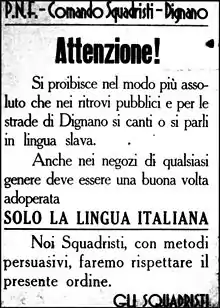
In September 1920, Mussolini said:
When dealing with such a race as Slavic – inferior and barbaric – we must not pursue the carrot, but the stick policy. We should not be afraid of new victims. The Italian border should run across the Brenner Pass, Monte Nevoso, and the Dinaric Alps. I would say we can easily sacrifice 500,000 barbaric Slavs for 50,000 Italians.
This period of fascist Italianization included the banning of the Croatian language in administration and courts between 1923 and 1925,[10] the Italianization of Croat first and last names in 1926[11][12] and the dissolution of Croatian societies, financial co-operatives and banks.[13] Hundreds of Croatian-speaking schools were closed by the state.[14]
Between February and April 1921, Croats in Istria became victims of Italian Fascist terror during the period of Fascist and anti-Fascist violence in Italy.[15] In response to the Proština rebellion, led by Croat Anti-fascists and local peasants, hundreds of Italian Squadrismo militia, Black Shirts, as well as members of the local army and police, attacked the Croat villages of Proština, Krnica, Marčana and Šegotići, in order to intimidate the Croat population. The Fascists burned Šegotići completely to the ground, while houses in the other villages were also burned. 400 peasants were arrested and imprisoned in Pula, several peasants died after being beaten to death.[15][16]
This period was therefore characterised as "centralising, oppressive and dedicated to the forcible Italianisation of the minorities"[17] consequently leading to a strong emigration and assimilations of Slovenes and Croats from the Julian March.[18]
Following the Axis invasion of Yugoslavia in April 1941, Italy occupied almost all of Dalmatia, as well as Gorski Kotar and the Italian government made stringent efforts to further Italianize the region. Italian occupying forces were accused of committing war crimes in order to transform occupied territories into ethnic Italian territories.[19] An example of this was the 1942 massacre in Podhum, when Italian forces murdered up to 118 Croat civilians and deported the remaining population to concentration camps.[20]
The Italian government operated concentration camps[21] for tens of thousands Slavic citizens, such as Rab concentration camp and one on the island of Molat, where thousands died, including hundreds of children.
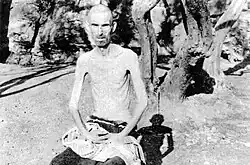
Nazi Germany
Nazi German racial theories towards the Croats were inconsistent and contradictory. On the one hand, the Nazis described the Croats officially as being "more Germanic than Slav", a notion made by Croatia's fascist dictator Ante Pavelić who imposed the view that the "Croatians were the descendants of the ancient Goths" who "had the Panslav idea forced upon them as something artificial".[22]
However, the Nazi regime continued to classify Slavs such as Croats as Untermensch, despite inclusion of Slavs such as Russians, Ukrainians, Czechs, Serbs, Bosnians and Croats in SS divisions.[23]
Furthermore, according to the book "Hitler's Table Talk", a collection of monologues by Adolf Hitler and conversations he had with close associates in the period from 1941 to 1944, Hitler mentioned that Croats should eventually become Germanized.[24]
According to Jozo Tomasevich, the Independent State of Croatia (NDH), was one of a few countries that Hitler called "Dreckstaaten", or "turd states",[25] that would need to be "reorganised" after the German victory.[24]
After the Anschluss of 1938, Austrian Burgenland Croats faced Germanization and were forced by the Nazi regime to assimilate. Minority rights that had been approved in 1937, such as Croatian language schools and bilingualism, were abolished under Nazi rule.[26]
Between 1941 and 1945, some 200,000[27] Croatian citizens of the NDH (including ethnic Croats as well as ethnic Serbs with Croatian nationality and Slovenes) were sent to Germany to work as a slave and forced labourers, mostly working in mining, agriculture and forestry. It is estimated that 153,000 of these labourers were said to have been "voluntarily" recruited, however in many instances this was not the case, as the workers that may have initially volunteered were forced to work longer hours and were paid less than their contracts had stipulated, they were also not allowed to return home after their yearly contract had ended, at which point their labour was no longer voluntary, but forced. Forced and slave labour were also conducted in Nazi concentration camps, such as in Buchenwald and Mittelbau-Dora.[28]
From 1941 to 1945, 3.8% of the population of Croatia had been sent to the Reich to work, which was higher than the European average.[28]
Chetniks
Regarding the realization of his Greater Serbian program Homogeneous Serbia, Stevan Moljević wrote in his letter to Dragiša Vasić in February 1942:[29]
(...) 2) Regarding our internal affairs, the demarcation with the Croats, we hold that we should as soon as an opportunity occurs, gather all the strength and create a completed act: occupy territories marked on the map, clean it before anyone pulls itself together. We would assume that the occupation would only be carried out if the main hubs were strong in Osijek, Vinkovci, Slavonski Brod, Sunja, Karlovac, Knin, Šibenik, Mostar and Metković, and then from within starts with an [ethnic] cleansing of all non-Serb elements. The guilty should have an open way – Croats to Croatia, Muslims to Turkey (or Albania). As for the Muslims, our government in London should immediately address the issue with Turkey. The English will also help us. (Question is!). The organization for the interior cleansing should be prepared immediately, and it could be because there are many refugees in Serbia from all "Serb lands" (...).
The tactics employed against the Croats were at least to an extent, a reaction to the terror carried out by the Ustashas, but Croats and Muslims living in areas intended to be part of Greater Serbia were to be cleansed of non-Serbs regardless, in accordance with Draža Mihailović's directive of 20 December 1941.[30] However the largest Chetnik massacres took place in eastern Bosnia where they preceded any significant Ustasha operations.[31] Chetnik ethnic cleansing targeted Croat civilians throughout areas of Croatia and Bosnia and Herzegovina, in which Croats were massacred and expelled, such as the Krnjeuša massacre and the Gata massacre, among many others. According to the Croatian historian, Vladimir Žerjavić, Chetnik forces killed between 18,000–32,000 Croats during World War II, mostly civilians.[32] Some historians regard Chetnik actions during this period as constituting genocide.[33][34][35]
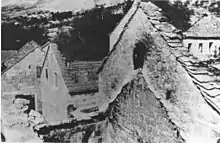
Written evidence by Chetnik commanders indicates that terrorism against the non-Serb population was mainly intended to establish an ethnically pure Greater Serbia in the historical territory of other ethnic groups (most notably Croatian and Muslim, but also Bulgarian, Romanian, Hungarian, Macedonian and Montenegrin). In Elaborate of the Chetnik's Dinaric Battalion from March 1942, it's stated that the Chetniks' main goal was to create a "Serbian national state in the areas in which the Serbs live, and even those to which Serbs aspire (Bosnia and Herzegovina, Lika and part of Dalmatia) where "only Orthodox population would live".[29] It is also stated that Bosniaks should be convinced that Serbs are their allies, so they wouldn't join the Partisans, and then kill them."[36]
Regarding the campaign, Chetnik commander Milan Šantić said in Trebinje in July 1942, "The Serb lands must be cleansed from Catholics and Muslims. They will be inhabited only by the Serbs. Cleansing will be carried out thoroughly, and we will suppress and destroy them all without exception and without pity, which will be the starting point for our liberation.[37] Mihailović went further than Moljević and requested over 90 percent of the NDH's territory, where more than 2,500,000 Catholics and over 800,000 Muslims lived (70 percent of the total population, with Orthodox Serbs the remaining 30 percent). [37]
According to Bajo Stanišić, the final goal of the Chetniks was the "founding of a new Serbian state, not a geographical term but a purely Serbian, with four basic attributes: the Serbian state [Greater Serbia], the Serb King [of] the Karađorđević dynasty, Serbian nationality, and Serbian faith. The Balkan federation is also the next stage, but the main axis and leadership of this federation must be our Serbian state, that is, the Greater Serbia.[38]
Yugoslav Wars
After Serbian President Slobodan Milošević's assumption of power in 1989, various Chetnik groups made a "comeback"[39] and his regime "made a decisive contribution to launching the Chetnik insurrection in 1990–1992 and to funding it thereafter," according to the political scientist Sabrina P. Ramet.[40] Chetnik ideology was influenced by the memorandum of the Serbian Academy of Sciences and Arts.[40] Serbs in north Dalmatia, Knin, Obrovac, and Benkovac held the first anti-Croatian government demonstrations.[41] On 28 June 1989, the 600th anniversary of the Battle of Kosovo, exiled Croatian Serb Chetnik commander Momčilo Đujić bestowed the Serbian politician Vojislav Šešelj with the title of voivode, encouraging him to "expel all Croats, Albanians, and other foreign elements from holy Serbian soil", stating he would return to the Balkans only when Serbia was cleansed of "the last Jew, Albanian, and Croat".[42]
Šešelj is a major proponent of a Greater Serbia with no ethnic minorities, but "ethnic unity and harmony among Orthodox Serbs, Catholic Serbs, Muslim Serbs and atheist Serbs".[43] In late 1991, during the Battle of Vukovar, Šešelj went to Borovo Selo to meet with a Serbian Orthodox Church bishop and publicly described Croats as a genocidal and perverted people.[44] In May and July 1992, Šešelj visited the Vojvodinian village of Hrtkovci and publicly started the campaign of persecution of local ethnic Croats.[45][46]
16,000 Croats were killed during the Croatian War of Independence, 43.4% of whom were civilians,[47] largely through massacres and bombings that occurred during the war.[48] The total number of expelled Croats and other non-Serbs during the Croatian War of Independence ranges from 170,000 (ICTY),[49] 250,000 (Human Rights Watch)[50] or 500,000 (UNHCR).[51] Croatian Serbs forces together with Yugoslav People's Army and Serbian nationalist paramilitaries committed numerous war crimes against Croat civilians.[52]
According to the Croatian Association of Prisoners in Serbian Concentration Camps, a total of 8,000 Croatian civilians and prisoners of war (a large number after the fall of Vukovar) went through Serb prison camps such as Sremska Mitrovica camp, Stajićevo camp, Niš camp and many others where many were heavily abused and tortured. A total of 300 people never returned from them.[53] A total of 4,570 camp inmates started legal action against former Serbia and Montenegro (now Serbia) for torture and abuse in the camps.[54] Croatia regained control over most of the territories occupied by the Croatian Serb rebels in 1995.
War crimes and acts of ethnic cleansing were also committed by the Bosnian Serb and Muslim (Bosniak) armies against Bosnian Croat civilians, during the Bosnian War, from 1992-1995.[55][56][57][58][59] 490,000 Bosnian Croats (or 67% of the population) became displaced during the conflict.[60] In the Serb-controlled Republika Srpska entity, the population of Croats in 2011, has decreased by 8.1% since 1991, mostly as a result of war.[61]
.svg.png.webp) The borders of Greater Serbia as advocated by Serbian Radical politician Vojislav Šešelj, defined by the Virovitica–Karlovac–Karlobag hypothetical boundary to the west.[62]
The borders of Greater Serbia as advocated by Serbian Radical politician Vojislav Šešelj, defined by the Virovitica–Karlovac–Karlobag hypothetical boundary to the west.[62]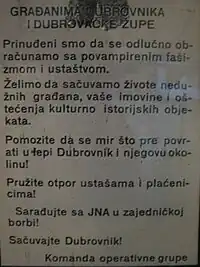
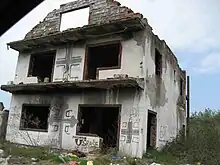 Bosnian Croat house defaced with graffiti: Serbian cross, "Red Star champion", "Usraše se Ustaše" (Ustashas shat their pants) and "God protects Serbs"
Bosnian Croat house defaced with graffiti: Serbian cross, "Red Star champion", "Usraše se Ustaše" (Ustashas shat their pants) and "God protects Serbs"
21st century
Croats were recognised in Serbia as a minority group just after 2002.[63] According to some estimates, the number of Croats who left Serbia under political pressure from the Milošević government may have been between 20,000 and 40,000.[64] According to Tomislav Žigmanov, Croats live in fear as they have become the most hated minority group in Serbia.[65] The Government of Croatia contends that anti-Croat sentiment is still prevalent in Serbia.[66]
In October 2021, a local Croatian-language weekly newspaper in Serbia's Vojvodina region, Hrvatska riječ, reported that a grammar book for eighth-grade pupils stated that the Serbian, Slovenian, Macedonian and Bulgarian languages are South Slavic languages while "Croats, Bosniaks and some Montenegrins call the Serbian language Croatian, Bosnian, Bosniak or Montenegrin".
The textbook was approved by the Serbian Institute for the Improvement of Education, a state education institution.
The wording of the Serbian textbook has been criticised by the Institute of Croatian Language and Linguistics, by Žigmanov, president of the Democratic Alliance of Croats in Vojvodina, and by Jasna Vojnić, president of the Croatian National Council in Serbia, an organisation which represents the interests of the Croat minority in the country.[67]
Destruction of cultural heritage
In 1891, Croatian archeologist Lujo Marun found a sarcophagus of 9th century Croatian duke in a village Biskupija near Knin.[68] These remains were later identified to most likely belong to Branimir of Croatia.[68] On the next day, the local Orthodox Serbs reportedly re-opened the grave and vandalized the remains.[68] In 1983, someone vandalized 9th century Croatian pre-Romanesque Church of Holy Salvation in Cetina by destroying Croatian interlace ornaments on it, in order to remove the proof of its old-Croatian origin.[69]
Modern Italy
Historical conflicts have existed between Croatians and Italians over the region of Dalmatia, which is now controlled by Croatia and has been claimed as historically Italian territory. Italian president Giorgio Napolitano provoked an angry reaction from his Croatian counterpart after criticizing the actions of Croatians in Dalmatia, which he described as "Slavic expansionist" with allegations of ethnic cleansing.[70]
The reaction from the Croatian side resulted in a cancellation of state visit by the Italian president. The European Union intervened and attempted to defuse the row between the two countries.[71]
In February 2019, Italian politician, and then President of the European Parliament, Antonio Tajani, held a speech at the National Memorial Day of the Exiles and Foibe commemoration in Basovizza (Trieste) which aroused an outrage in Slovenia and Croatia, most notably the statement "Long live Trieste, long live Italian Istria, long live Italian Dalmatia".[72][73] After numerous high representatives of the two countries strongly condemned the speech for its revisionist and irredentist connotations, Tajani stated his words were intended as "a message of peace"[74] and were misinterpreted.[75][73] The Slovenian party Social Democrats launched a petition demanding Tajani's immediate resignation as president of the EU Parliament, which was signed among others by several former presidents of Slovenia and Croatia.[76]
Pejorative terms for Croats
- Ustasha: Derogatory slur used primarily by Serbian nationalists in reference to the Independent State of Croatia and the fascist Ustasha movement during World War II in Yugoslavia.
- Wog (Australia): In Australian English, the slur "wog" is used to refer to immigrants of Southern European, Mediterranean, Middle Eastern, and sometimes Eastern European ethnicity or appearance, and has thus also been applied to ethnic Croat immigrants.
See also
References
- Cohen, Philip J.; Riesman, David (1996). Serbia's Secret War: Propaganda and the Deceit of History. Texas A&M University Press. ISBN 0-89096-760-1.
- Čoralić, Lovorka (1998). "Review of "Stanko Bačić, Osvrt na knjigu »Pravoslavna Dalmacija« E. Nikodima Milaša, Matica hrvatska – Zadar, Zadar, 1998., 404 str."". Croatica Christian Periodica (in Croatian). 22 (42): 151–153.
- Bačić, Stanko (1998). Osvrt na knjigu "Pravoslavna Dalmacija" E. Nikodima Milaša [Critics of points of view of Nikodim Milaš in his book "Orthodox Dalmatia"] (in Croatian). Zadar: Matica hrvatska. ISBN 953-6419-19-X.
- Grčević, Mario (1998). "Zablude o istočnohercegovačkim govorima kao dijalekatnoj osnovici hrvatskoga književnoga jezika" [Zablude o istočnohercegovačkim govorima kao dijalekatnoj osnovici hrvatskoga književnoga jezika]. Jezik (in Croatian). 46 (2): 44–56.
- Grčević, Mario (2019), Ime "Hrvat" u etnogenezi južnih Slavena [The name "Croat" in the ethnogenesis of the southern Slavs], Zagreb, Dubrovnik: Hrvatski studiji Sveučilišta u Zagrebu – Ogranak Matice hrvatske u Dubrovniku, p. 124–125, 236, ISBN 978-953-7823-86-3
- In the Name of Independence: The Unmaking of Tito's Yugoslavia, Branko Belan, 2010, p. 82,83
- Bilandžić, Dušan (1999). Hrvatska moderna povijest. Golden marketing. p. 31. ISBN 953-6168-50-2.
- "Buying and Selling the Istrian Goat: Istrian Regionalism, Croatian Nationalism, and EU Enlargement", (book), John E. Ashbrook, 2008, Pg. 37
- Verginella, Marta (2011). "Antislavismo, razzismo di frontiera?". Aut aut (in Italian). Il Saggiatore. ISBN 9788865761069.
- Pușcariu, Sextil (1926). Studii istroromâne. Vol. 2. București.
{{cite book}}: CS1 maint: location missing publisher (link) - Regio decreto legge 10 Gennaio 1926, n. 17: Restituzione in forma italiana dei cognomi delle famiglie della provincia di Trento
- Mezulić, Hrvoje; R. Jelić (2005) Fascism, baptiser and scorcher (O Talijanskoj upravi u Istri i Dalmaciji 1918–1943.: nasilno potalijančivanje prezimena, imena i mjesta), Dom i svijet, Zagreb, ISBN 953-238-012-4
- "A Historical Outline Of Istria". Archived from the original on January 11, 2008.
- Cresciani, Gianfranco (2004). "Clash of civilisations". Italian Historical Society Journal. 12 (2): 4.
- "Proštinska buna". istrapedia. 8 July 2014.
- "Ugušena Proštinska buna - prvi antifašistički otpor u Istri". Antifašistički vjesnik.
- Sluga, Glenda; Sluga, Professor of International History Glenda (January 11, 2001). The Problem of Trieste and the Italo-Yugoslav Border: Difference, Identity, and Sovereignty in Twentieth-Century Europe. SUNY Press. ISBN 9780791448236 – via Google Books.
- "Le pulizie etniche in Istria e nei Balcani", Inoslav Bešker, retrieved 29. Feb. 2020
- Dizdar, Zdravko (2005). "Italian Policies Toward Croatians In Occupied Territories During The Second World War". Review of Croatian History Issue (1): 179–210.
- Report on Italian War Crimes against Yugoslavia and its people 1946, p. 138.
- "ELENCO DEI CAMPI DI CONCENTRAMENTO ITALIANI".
- Rich, Norman (1974) Hitler's War Aims: the Establishment of the New Order. New York: W. W. Norton & Company. p.276-7.
- Davies, Norman (2008) Europe at War 1939–1945: No Simple Victory. Pan Macmillan. pp.167,209.
- "Hitler o NDH: "Ta mala govnarska državica..."". Retrieved 19 October 2021.
- Tomasevich 2001, p. 778.
- "gradišćanski Hrvati | Hrvatska enciklopedija". Enciklopedija.hr. Retrieved 2017-03-10.
- Goldstein, Ivo (1999). Croatia: A History. Montreal, Quebec: McGill-Queen's University Press. p. 139. ISBN 978-0-7735-2017-2.
- Alexander von Plato; Almut Leh; Christoph Thonfeld (2010). Hitler's Slaves: Life Stories of Forced Labourers in Nazi-Occupied Europe. Berghahn Books. pp. 154–156. ISBN 978-1845459901.
- Nikola Milovanović – DRAŽA MIHAILOVIĆ, chapter "SMERNICE POLITIČKOG PROGRAMA I CILJEVI RAVNOGORSKOG POKRETA", edition "Rad", Belgrade, 1984.
- Tomasevich, Jozo (1975). War and Revolution in Yugoslavia. Stanford University Press. p. 259. ISBN 978-0-8047-0857-9.
- Hoare 2006, p. 143.
- Vladimir Geiger (2012). "Human Losses of the Croats in World War II and the Immediate Post-War Period Caused by the Chetniks (Yugoslav Army in the Fatherland) and the Partisans (People's Liberation Army and the Partisan Detachments of Yugoslavia/Yugoslav Army) and the Communist Authorities: Numerical Indicators". Review of Croatian History. Croatian Institute of History. VIII (1): 85–87. Retrieved 25 May 2020.
- Tomasevich, Jozo (2001). War and Revolution in Yugoslavia. Stanford University Press. p. 747. ISBN 978-0-80477-924-1.
- Redžić, Enver (2005). Bosnia and Herzegovina in the Second World War. New York: Taylor and Francis. p. 155. ISBN 978-0-71465-625-0.
- Hoare, Marko (2006). Genocide and Resistance in Hitler's Bosnia: The Partisans and Chetniks, 1941–1943. Oxford: Oxford University Press. p. 386. ISBN 978-0-19726-380-8.
- "Dinarska četnička divizija (4)". Hrvatski povijesni portal. Archived from the original on 2018-03-01. Retrieved 2018-03-07.
- Dizdar & Sobolevski 1999.
- Četnički zločini nad Hrvatima i Muslimanima u Bosni i Hercegovini tijekom Drugog svjetskog rata (1941.-1945.), Zvonimir Despot, Večernji list, 25. March 2020
- Mennecke, Martin (2012). "Genocidal Violence in the Former Yugoslavia". In Totten, Samuel; Parsons, William S. Centuries of Genocide: Essays and Eyewitness Accounts. New York: Routledge. ISBN 978-0-415-87191-4.
- Ramet 2006, p. 420.
- Tanner, Marcus (1997). Croatia: a nation forged in war. Yale University Press. p. 218. ISBN 0300076681.
- Velikonja, Mitja (2003). Religious Separation and Political Intolerance in Bosnia-Herzegovina. College Station, Texas: Texas A&M University Press. p. 246. ISBN 978-1-58544-226-3.
- "Vojislav Seselj: I Wanted a 'Greater Serbia'". Balkan Insight. 10 June 2013. Retrieved 28 March 2016.
- Renaud de la Brosse (4 February 2003). "Political Propaganda and the Plan to Create a "State for all Serbs" – Consequences of Using the Media for Ultra-Nationalist Ends – Part 3" (PDF). Office of the Prosecutor of the International Criminal Tribunal for the Former Yugoslavia. Retrieved 16 April 2012.
- Marcus Tanner (August 1992). "'Cleansing' row prompts crisis in Vojvodina". The Independent. Archived from the original on 2022-05-07. Retrieved 19 January 2011.
- Chuck Sudetic (26 July 1992). "Serbs Force An Exodus From Plain". New York Times. Retrieved 19 January 2011.
- Fink 2010, p. 469.
- index (December 11, 2003). "Utjecaj srbijanske agresije na stanovništvo Hrvatske". Index.hr. Retrieved November 24, 2017.
- Marlise Simons (10 October 2001). "Milosevic, Indicted Again, Is Charged With Crimes in Croatia". New York Times. Archived from the original on 20 May 2013. Retrieved 26 December 2010.
- "Milosevic: Important New Charges on Croatia". Human Rights Watch. 21 October 2001. Archived from the original on 25 December 2010. Retrieved 29 October 2010.
- UNHCR (August 5, 2005). "Home again, 10 years after Croatia's Operation Storm". UNHCR. Retrieved November 24, 2017.
- "Prosecution submission of an expert report of Reynaud J.M. Theunens pursuant to Rule 94bis" (PDF). The Hague: The International Criminal Tribunal for the Former Yugoslavia. December 16, 2003. p. 27633-27630, 27573 & 27565-27561. Retrieved 10 May 2011.
- Natalya Clark, Janine (2014). International Trials and Reconciliation: Assessing the Impact of the International Criminal Tribunal for the Former Yugoslavia. Routledge. ISBN 9781317974741.
- "Danijel Rehak ponovno izabran za predsjednika Hrvatskog društva logoraša". Vjesnik (in Croatian). 28 March 2004. Archived from the original on 30 April 2004. Retrieved 5 October 2010.
- A. D. Horne (22 August 1992). "Long Ordeal for Displaced Bosnian Muslims". The Washington Post. Retrieved 7 May 2020.
- "War Crimes in Bosnia-Hercegovina: U.N. Cease-Fire Won't Help Banja Luka". Human Rights Watch. June 1994. Retrieved 25 July 2019.
- "War and humanitarian action: Iraq and the Balkans" (PDF). UNHCR. 2000. p. 218. Retrieved 25 July 2019.
- Bell-Fialkoff 1993, p. 110.
- ANNEX IV: Policy of Ethnic Cleansing - Part Two: Ethnic Cleansing in BiH - I: Introduction, 27 May 1994, pp. 36–37
- Friedman 2013, p. 78.
- Mrduljaš 2011, pp. 530, 532.
- "Case information sheet" (PDF). (IT-03-67) Vojislav Šešelj trial. ICTY. Retrieved 2012-12-21.
He defined the so-called Karlobag-Ogulin-Karlovac-Virovitica line as the western border of this new Serbian state which he referred to as "Greater Serbia" and which included Serbia, Montenegro, Macedonia and considerable parts of Croatia and Bosnia and Herzegovina.
- "Srbija – MVEP • Hrvatska manjina u Republici Srbiji". rs.mvep.hr. Archived from the original on 2021-11-03. Retrieved 2020-04-09.
- "Informacije za Hrvate izvan domovine". March 11, 2009. Archived from the original on 2009-03-11.
- "Žigmanov: Hrvati u Srbiji žive u strahu jer su postali najomraženija manjina". N1 HR. Archived from the original on 2020-11-26. Retrieved 2020-04-09.
- "Croatian ministers call for putting an end to anti-Croat sentiment in Serbia", the official pages of the Government of the Republic of Croatia, 02. April 2015
- "Serbia Urged to Correct Schoolbooks Denying Croatian is a Language". 7 October 2021. Retrieved 7 October 2021.
- Milošević, Ante. "Sarkofag kneza Branimira. Duke Branimir's sarcophagus". Early Medieval Archaeology.
- Marasović, Tomislav (1995). "Crkva Sv. Spasa na vrelu Cetine Prilog tipološkoj analizi". Starohrvatska Prosvjeta. 3 (22): 41 – via Hrčak.
- "Row erupts between Croatia, Italy over wartime killings". The Irish Times.
- "Row erupts between Croatia, Italy over wartime killings". The Irish Times.
- "EP President Tajani says "Italian Istria and Dalmatia" remark was misinterpreted". N1 HR. 2019-02-11. Retrieved 2019-02-12.
- "Cerarja Tajanijevo opravičilo ni prepričalo. Tajanija k odstopu poziva tudi NSi". rtvslo.si (in Slovenian). 2019-02-12. Retrieved 2019-02-12.
- "Tajani se je za svoje izjave v Bazovici opravičil". rtvslo.si (in Slovenian). 2019-02-11. Retrieved 2019-02-12.
- Potič, Zoran (2019-02-11). "Tajani se je opravičil Sloveniji in Hrvaški za besede ob fojbah". Dnevnik (in Slovenian). Retrieved 2019-02-12.
- "Peticija za odstop Tajanija: podpisala sta se tudi Kučan in Mesić". Siol.net (in Slovenian). 2019-02-12. Retrieved 2019-02-13.
Sources
- Bell-Fialkoff, Andrew (1993). "A Brief History of Ethnic Cleansing". Foreign Affairs. 72 (3): 110–121. doi:10.2307/20045626. JSTOR 20045626. S2CID 27821821.
- Dizdar, Zdravko; Sobolevski, Mihael (1999). Prešućivani četnički zločini u Hrvatskoj i u Bosni i Hercegovini 1941–1945 (in Serbo-Croatian). Zagreb: Hrvatski institut za povijest.
- Fink, George (2010). Stress of War, Conflict and Disaster. Academic Press. ISBN 978-0-12-381382-4.
- Friedman, Francine (2013). Bosnia and Herzegovina: A Polity on the Brink. Routledge. ISBN 978-1-134-52754-0.
- Mrduljaš, Saša (2011). "Značenje političkih odnosa u Bosni i Hercegovini za Dalmaciju" [Relevance of the political relations in Bosnia and Herzegovina to Dalmatia]. New Presence: Review for Intellectual and Spiritual Questions (in Croatian). Institute of Social Sciences Ivo Pilar. 9 (3): 521–544.
- Nedeljković, Dušan (1946). Report on Italian crimes against Yugoslavia and its peoples (Report). Državna komisija za utvrđivanje zločina okupatora i njihovih pomagača.
- Ramet, Sabrina P. (2006). The Three Yugoslavias: State-Building and Legitimation, 1918–2005. New York: Indiana University Press. ISBN 978-0-25334-656-8.
External links
- "The U.S. Media and Yugoslavia, 1991-1995" (book), James J. Sadkovich, Greenwood Publishing Group, 1998.